

Dyslexia1. Dyslexic words. America's largest organization for youth volunteering opportunities, with 2,700,000 members and counting. Dyslexia Statistics, Facts and Figures. Test for Dyslexia: 37 Common Symptoms. Dyslexia Symptoms, Causes, Treatment - What type of treatment is available for dyslexia? What type of treatment is available for dyslexia?
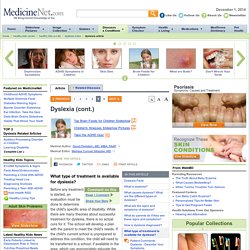
Before any treatment is started, an evaluation must be done to determine the child's specific area of disability. While there are many theories about successful treatment for dyslexia, there is no actual cure for it. The school will develop a plan with the parent to meet the child's needs. If the child's current school is unprepared to address this condition, the child will need to be transferred to a school, if available in the area, which can appropriately educate the dyslexic child. The plan maybe implemented in a Special Education setting or in the regularclassroom. In addition to what the school has to offer, there are alternative treatment options available outside the school setting. Perhaps the most important aspect of any treatment plan is attitude. For further information regarding dyslexia, ask your child's pediatrician for assistance, contact your local public school district office, or one of the following: Patient Comments.
Four Things All Educators Should Understand About the Dyslexic Brain. What do you think of when you hear the word dyslexic?

All too often the reflex reaction is a stream of negative associations -- "slow reader," "under performance," "extra time on exams," "difficulty spelling. " While it is true that these are common symptoms in students with dyslexia, they are surmountable problems. For any educator, the key to unleashing academic success in dyslexic students lies in understanding how their brains work. A recent Edutopia blog post by Judy Willis made the case for adding neuroscience to the curriculum for student teachers. When it comes to tackling dyslexia in the classroom, this understanding would be hugely beneficial, as it would help teachers explain to students exactly why they are having problems and what they can do to overcome them.
Here are four key characteristics of the dyslexic brain that are crucial for educators to understand. From One Teacher to Another by Liz Ball. Dyslexics are lifelong learners.
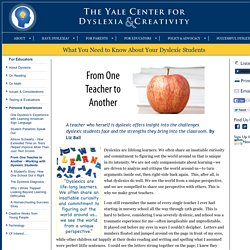
We often share an insatiable curiosity and commitment to figuring out the world around us that is unique in its intensity. We are not only compassionate about learning—we are driven to analyze and critique the world around us—to turn arguments inside out, then right-side back again. This, after all, is what dyslexics do well. We see the world from a unique perspective, and we are compelled to share our perspective with others. This is why we make great teachers. I can still remember the name of every single teacher I ever had starting in nursery school all the way through 12th grade. A Classroom Reading List. Reading List for Creating a Classroom Reading Culture These are titles that hooked all my students, regardless of ability.
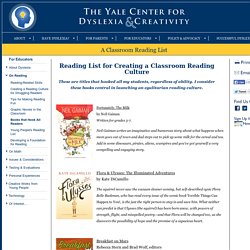
I consider these books central in launching an egalitarian reading culture. Fortunately, The Milk by Neil Gaiman Written for grades 3-7. Helping dyslexic children within the classroom. © 2000, Patricia Hodge Dip.spld(dyslexia) Proficient reading is an essential tool for learning a large part of the subject matter taught at school.
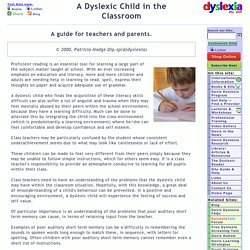
With an ever increasing emphasis on education and literacy, more and more children and adults are needing help in learning to read, spell, express their thoughts on paper and acquire adequate use of grammar. A dyslexic child who finds the acquisition of these literacy skills difficult can also suffer a lot of anguish and trauma when they may feel mentally abused by their peers within the school environment, because they have a learning difficulty. Much can be done to alleviate this by integrating the child into the class environment (which is predominantly a learning environment) where he/she can feel comfortable and develop confidence and self esteem. Class teachers may be particularly confused by the student whose consistent underachievement seems due to what may look like carelessness or lack of effort.
HOW TEACHERS CAN ACCOMMODATE THE DYSLEXIC STUDENT. *Do not give them open-ended questions that involve abstract or incomplete instructions.
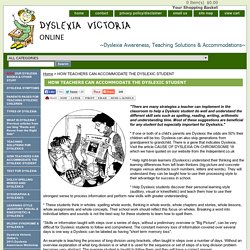
*Do not base the student's marks on spelling, punctuation or grammatical errors. Errors in assignments should be corrected for them. Spelling, punctuation and grammar are very abstract concepts for them that the right brain does not easily process and cannot visualize them as concrete images. If these errors must be corrected before a student hands in an assignment then permit someone else to edit the mistakes in spelling, grammar and punctuation. Brain Scans Show Dyslexics Read Better with Alternative Strategies. By Abigail Marshall; © 2003 DDAI.

Scientists studying the brain have found that dyslexic adults who become capable readers use different neural pathways than nondyslexics. This research shows that there are two independent systems for reading: one that is typical for the majority of readers, and another that is more effective for the dyslexic thinker. NIMH Study of Dyslexic Adults Researchers Judith Rumsey and Barry Horwitz at the National Institute of Mental Health used positron emission tomography (PET) to compare regional cerebral blood flow (rCBF) among dyslexic and nondyslexic men. The dyslexic subjects had childhood histories of dyslexia and continued to show some symptoms related to reading, but their overall reading ability varied. Research correlating brain activity with reading ability showed an intriguing inverse relationship between reading ability and cerebral blood flow patterns. The researchers explained: Technology helps dyslexics decode written word.
Kevin Riordan, Inquirer Columnist Posted: Sunday, November 30, 2014, 11:59 PM I remember yearning to read the comics in the Sunday paper.
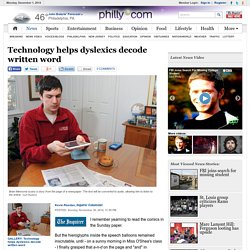
The Reality of Dyslexia - Millions Struggle.